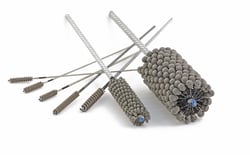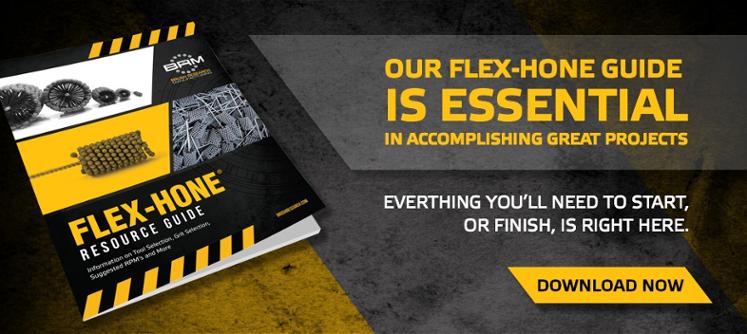 Flex-Hone® tools remove burrs and improve surface finish at the same time. Made in the USA by Brush Research Manufacturing (BRM), these versatile and easy-to-use honing tools are available for any type or size of cylinder.
Flex-Hone® tools remove burrs and improve surface finish at the same time. Made in the USA by Brush Research Manufacturing (BRM), these versatile and easy-to-use honing tools are available for any type or size of cylinder.
Standard Flex-Hone® tools include surface finishing and deburring tools for cylinders with inner diameters (ID) as small as 4 mm. In addition to tool size, Flex-Hone® users need to select the abrasive type and grit size. This article explains what you need to know.
How Flexible Honing Works
For starters, Flex-Hone® users need to understand that flexible honing isn’t a heavy-duty material removal process. Rather, it’s a low-temperature, low-pressure abrading process that imparts an ideal surface finish. Flex-Hone® tools feature abrasive globules or balls that are permanently laminated to flexible nylon filaments. This independent suspension means that BRM ball hones are self-centering and self-aligning to bore, which contributes to their ease-of-use. The flexible hone's metal stem supports its use with handheld power tools or production equipment.
Bore Sizes and Tool Diameters
For Flex-Hone® users, it’s important to know that BRM ball hones are always supplied and used in an oversized condition. In other words, a flexible hone for a 4 mm bore has a tool diameter that’s slightly larger than 4 mm. What happens when a cylinder’s bore size is between two Flex-Hone® sizes then? The answer is simple: choose and use the larger-diameter tool.
BRM supplies smaller-diameter Flex-Hone® in a range of tool diameters.
- BC series Flex-Hone® tools® tools range in size from 4 mm (0.157") to 76 mm (3").
- Diamond Flex-Hone® tools® tools range in size from 4 mm to 19 mm (3/4").
Both types of Flex-Hone® tools are designed for smaller-diameter cylinders, but tool diameter alone won't help you choose the ball hone that you need.
Abrasive Types
Diamond Flex-Hone® tools are used to surface finish and deburr harder materials. Examples include carbide, ceramic, hardened tool steel, and heat-treated steel. BC series Flex-Hone® tools are used with industrial metals.
As the chart below explains, the base material determines the abrasive type to use.
|
Use This Abrasive Type |
With These Base Materials |
|
Silicon Carbide (SC) |
Cast iron Mild steel Stainless steel |
|
Aluminum Oxide (AO) |
Aluminum Brass Bronze Softer metals |
|
25% Zirconia / 75% Alumina (Z25) |
Cast iron Low carbon steels Medium carbon steels Stainless steel |
|
40% Zirconia / 60% Alumina (Z40) |
Cast iron Low carbon steels Medium carbon steels Stainless steel |
|
Boron Carbide (BC) |
Medium carbon steels High carbon steels Heat-treated steels to 50 Rc Titanium |
|
Tungsten Carbide (WC) |
High carbon steel alloys More exotic space age alloys |
|
Levigated Alumina (LA) |
Final polish on many materials |
|
Diamond |
Carbide Ceramic Hardened tool steel Heat treated steel |
Grit Sizes
In addition to tool diameter and abrasive type, Flex-Hone® users need to specify the grit size. As a rule, two factors drive grit-size selection.
- the amount of work to perform
- the degree of surface improvement that's requred
There are other factors to consider, too. If the starting finish is course, you may need to use several Flex-Hone® tools with progressively finer grits to meet your final surface finish requirements. For more information about grit selection, tool selection, and Flex-Hone® use, download the Flex-Hone Resource® Guide.









